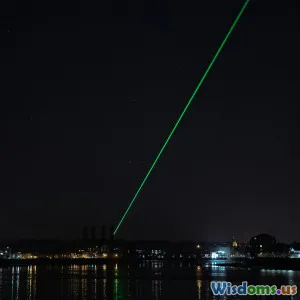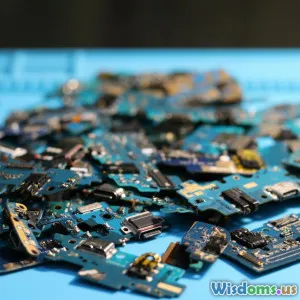
Why Lasers May Replace Traditional Artillery in Next Gen Warfare
8 min read Explore why lasers are poised to replace traditional artillery in future warfare, revolutionizing military technology and combat strategy. (0 Reviews)
Why Lasers May Replace Traditional Artillery in Next-Gen Warfare
War has always been a game of technology – from knives to guns, catapults to tanks. Today, a new revolutionary technology is on the cusp of changing the battlefield landscape: lasers. As militaries invest billions into directed energy weapons, laser systems are becoming not just feasible but strategically vital. This article dives into why lasers may soon replace traditional artillery in future warfare, examining their technological advantages, operational benefits, and strategic implications.
Introduction: The Dawn of Directed Energy on the Battlefield
How do you replace century-old artillery that has shaped warfare since the industrial age? The answer lies not in refinement but in radical innovation. Traditional artillery is heavy, requires ammunition supply lines, and is constrained by ballistic trajectories. In contrast, laser weapons offer speed-of-light engagement, deep magazine capacity owing to their reliance on electricity, and the potential to engage multiple targets at once with unparalleled precision.
The prospect of lasers replacing cannon shells on the frontline may sound like science fiction, but countries like the United States, China, Israel, and Russia have been actively testing and deploying laser weapon systems in defense roles. This article explores facets of this transformation, why it matters, and when we might expect laser systems to dominate.
Laser Weapon Systems: A Revolution in Military Technology
What Are Laser Weapons?
Laser weapons, or Directed Energy Weapons (DEWs), emit concentrated beams of light that can damage or destroy enemy systems by heating targets to critical temperatures. Unlike kinetic weapons, they impose no recoil and don't depend on explosive propellants or bulky ammunition.
Cutting-edge military programs include the U.S. Navy's Laser Weapon System (LaWS), capable of countering drones and small boats, and Israel’s Iron Beam, which destroys incoming rockets using high-energy lasers. These systems showcase practical achievements and clear trajectories of innovation.
Advantages Over Traditional Artillery
-
Speed of Engagement: Lasers strike their target at the speed of light, meaning no travel time and near-instantaneous neutralization.
-
Logistical Simplicity: There’s no need for shell, propellant, or complex ammunition supply lines; power generators suffice.
-
Reduced Collateral Damage: Precision targeting drastically reduces unintended injuries or destruction, essential in complex combat zones.
-
Cost Efficiency: Each laser shot costs only cents worth of electricity, far cheaper than artillery shells costing hundreds to thousands of dollars each.
Limitations and Developing Solutions
Current challenges include weather dependence — fog, rain, and dust can scatter or absorb laser energy — and power generation requirements for high-energy systems. However, innovations in solid-state lasers, adaptive optics, and mobile power sources have steadily mitigated these issues.
Operational Benefits: How Lasers Change the Rules of Engagement
Immediate Targeting and Multi-Target Engagement
Traditional artillery involves complex targeting calculations and reload times. Lasers can instantly switch between targets. For example, the U.S. Army’s Mobile High Energy Laser (MEHEL) program has demonstrated capability against UAV swarms, defeating multiple drones in seconds. This dramatically shifts defensive and offensive tactics in modern combat.
Reduced Physical Footprint for Forces
Artillery requires large, cumbersome platforms, storage for ammunition, and significant maintenance. Laser weapons can be mounted on lighter vehicles or vessels, including ships literally replacing some close-in weapon systems (CIWS). This reduces battlefield footprints, enhances mobility, and allows for quicker redeployment.
Enhanced Survivability and Sustainability
With no requirement for ballistic ammunition, forces can fight longer without resupply, especially crucial in remote or contested areas. Moreover, lasers reduce risks associated with explosive rounds — ammunition depots are vulnerable targets, and accidents less frequent with electrical systems.
Strategic Implications for Modern Warfare
Shifts in Force Structure and Doctrine
Replacing artillery with lasers will force armies to rethink doctrine, logistics, and force structure. Infantry, armored formations, and naval units equipped with directed-energy systems can adopt more agile tactics focused on speed, precision, and layered defense strategies.
Impact on Global Power Dynamics
Countries investing heavily in laser technology, like the U.S., China, and Russia, may gain significant advantages. Beyond kinetic battlefield effects, lasers can become tools in deterrence, blurring the lines between conventional and electronic warfare domains.
Ethical and Legal Considerations
Laser weapons raise questions about rules of engagement and bans on blinding weapons under international humanitarian law. However, military-grade lasers designed mainly for disabling vehicles and projectiles sidestep many previous concerns, reframing legal debates.
Case Studies: Progress in Laser Weapon Deployments
The U.S. Navy's LaWS
Installed aboard the USS Ponce in 2014, LaWS demonstrated real-world capability by shooting down drones and small fast boats during Middle Eastern operations. Its success validated laser integration aboard naval vessels and inspired further deployment alongside missile defense.
Israel’s Iron Beam
Setup in 2017 near Gaza, Iron Beam effectively neutralizes short-range rockets and mortar shells. It complements Iron Dome by addressing close-in threats where traditional missile interceptors are cost-prohibitive.
China’s Laser Artillery Advancements
Reports show China developing truck-mounted laser systems capable of disabling enemy sensors and drones at ranges of several kilometers. This indicates laser weapons’ relevance not only in defense but as force multipliers in offensive ground warfare.
Conclusion: The Laser Future of Warfare is Near
As military technology advances, the fusion of physics and engineering makes lasers more practical and potent than ever. The undeniable benefits—speed, precision, cost-effectiveness, and operational advantages—position lasers as strong contenders to eventually replace traditional artillery systems.
Despite existing constraints like weather dependency and power requirements, continuous innovation promises to surmount these hurdles. The military landscape is on the brink of transformation where speed-of-light weapons redefine combat, logistics, and strategy.
For defense planners and technologists, embracing laser weaponry isn’t just a futuristic concept; it’s a present imperative shaping next-gen warfare. The artillery of tomorrow could well be the lasers of today—silent, swift, and devastatingly precise.
Rate the Post
User Reviews
Other posts in Directed Energy Weapons
Popular Posts


















